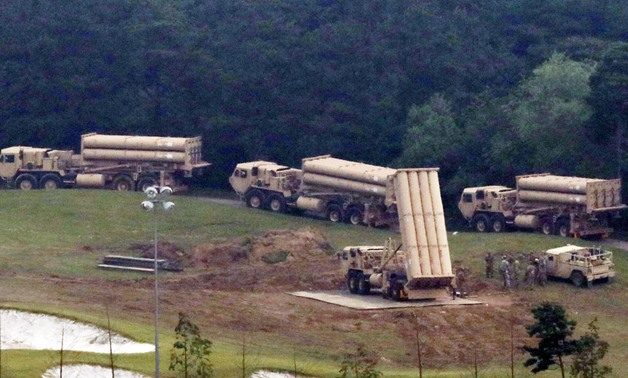
Terminal High Altitude Area Defense (THAAD) interceptors are seen as they arrive at Seongju, South Korea, September 7, 2017. Lee Jong-hyeon/News1 via REUTERS
SEOUL/UNITED NATIONS - 7 September 2017: South Korean protesters clashed with thousands of police over the deployment of a defense system aimed at countering North Korean missile attacks, while China and the United States discussed options to rein in Pyongyang.
The United States wants the U.N. Security Council to impose an oil embargo on North Korea, ban its exports of textiles and the hiring of North Korean laborers abroad, and subject leader Kim Jong Un to an asset freeze and travel ban, according to a draft resolution seen by Reuters on Wednesday.
Pressure from Washington has ratcheted up since North Korea conducted its sixth and largest nuclear test on Sunday. That test, along with a series of missile launches, showed Pyongyang was close to achieving its goal of developing a powerful nuclear weapon that could reach the United States.
Amid the rising tensions, Seoul installed the four remaining launchers of the U.S. anti-missile Terminal High Altitude Area Defense (THAAD) system on a former golf course in the south early on Thursday. Two launchers had already been deployed.
More than 30 people were wounded when around 8,000 South Korean police broke up a blockade of about 300 villagers and civic groups opposed to the THAAD system deployment, fire officials said.
The decision to deploy the THAAD system has drawn strong objections from China, which believes its radar could be used to look deeply into its territory and will upset the regional security balance.
“SEE WHAT HAPPENS”
U.S. President Donald Trump has urged China, North Korea’s biggest ally and trading partner, to do more to rein in its neighbor which has pursued its missile and nuclear weapons programs in defiance of U.N. sanctions and international condemnation.
U.S. Treasury Secretary Steve Mnuchin said he had an executive order ready for Trump to sign that would impose sanctions on any country that trades with Pyongyang if the United Nations does not put additional sanctions on North Korea.
Trump and Chinese President Xi Jinping committed on a phone call on Wednesday to “take further action with the goal of achieving the denuclearization of the Korean peninsula”, the White House said.
“President Xi would like to do something. We’ll see whether or not he can do it. But we will not be putting up with what’s happening in North Korea,” Trump told reporters, although he offered no specifics.
“I believe that President Xi agrees with me 100 percent,” he said.
Asked whether he was considering a military response to North Korea, Trump said: “Certainly, that’s not our first choice, but we will see what happens.”
Xi told the U.S. president during their 45-minute call that the North Korean issue must be resolved through “dialogue and consultation”.
The United States had set aside for now plans to end a U.S. trade agreement with South Korea, a senior administration official said on Wednesday. The trade issue is unrelated to North Korea but has been a source of tension between the two allies.
MOON, ABE MEET
Japanese Prime Minister Shinzo Abe and South Korean President Moon Jae-in spoke at a regional meeting in the eastern Russian city of Vladivostok and agreed to try to persuade China and Russia to cut off oil to North Korea as much as possible, according to South Korean officials.
The European Union’s foreign and defense ministers will discuss further sanctions for North Korea on Thursday, the bloc’s top diplomat said ahead of a EU ministers’ meeting in the Estonian capital.
However, sanctions have so far done little to stop North Korea boosting its nuclear and missile capacity as it faces off with Trump.
China and Russia have advocated a “freeze for freeze” plan, where the United States and South Korea would stop major military exercises in exchange for North Korea halting its weapons programs, but neither side appears willing to budge.
South Korean Marines wrapped up a three-day firing drill on Thursday aimed at protecting its islands just south of the border with North Korea, while the air force will finish up a week-long drill on Friday.
North Korea says it needs to develop its weapons to defend itself against what it sees as U.S. aggression.
South Korea and the United States are technically still at war with North Korea after the 1950-53 Korean conflict ended with a truce, not a peace treaty.


Comments
Leave a Comment